Other common names:
- Hairy galinsoga: French weed, common quickweed, shaggy soldier, ciliate galinsoga, fringed quickweed, quickweed, Peruvian daisy, shaggy galinsoga
- Smallflower galinsoga: gallant soldier
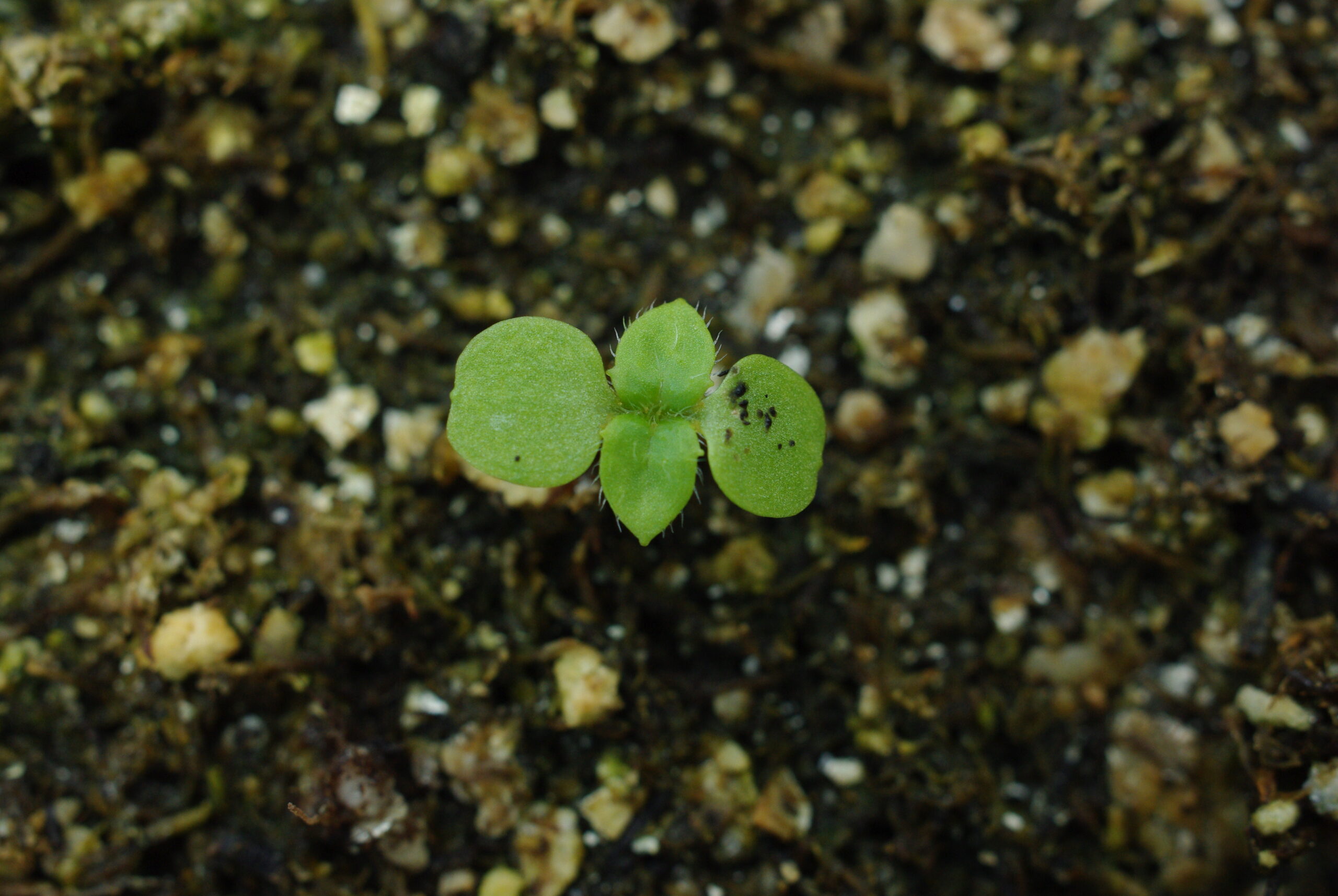
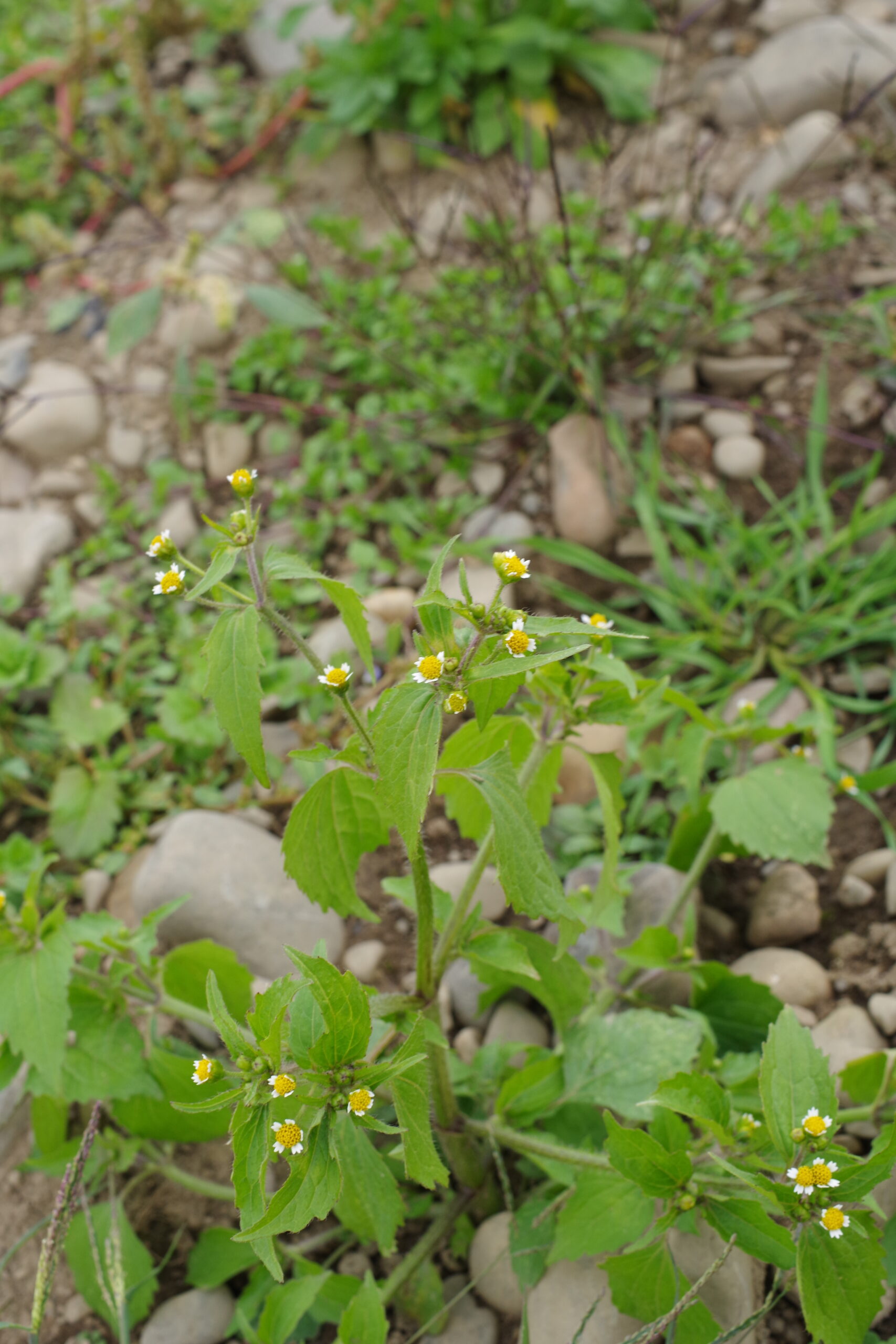
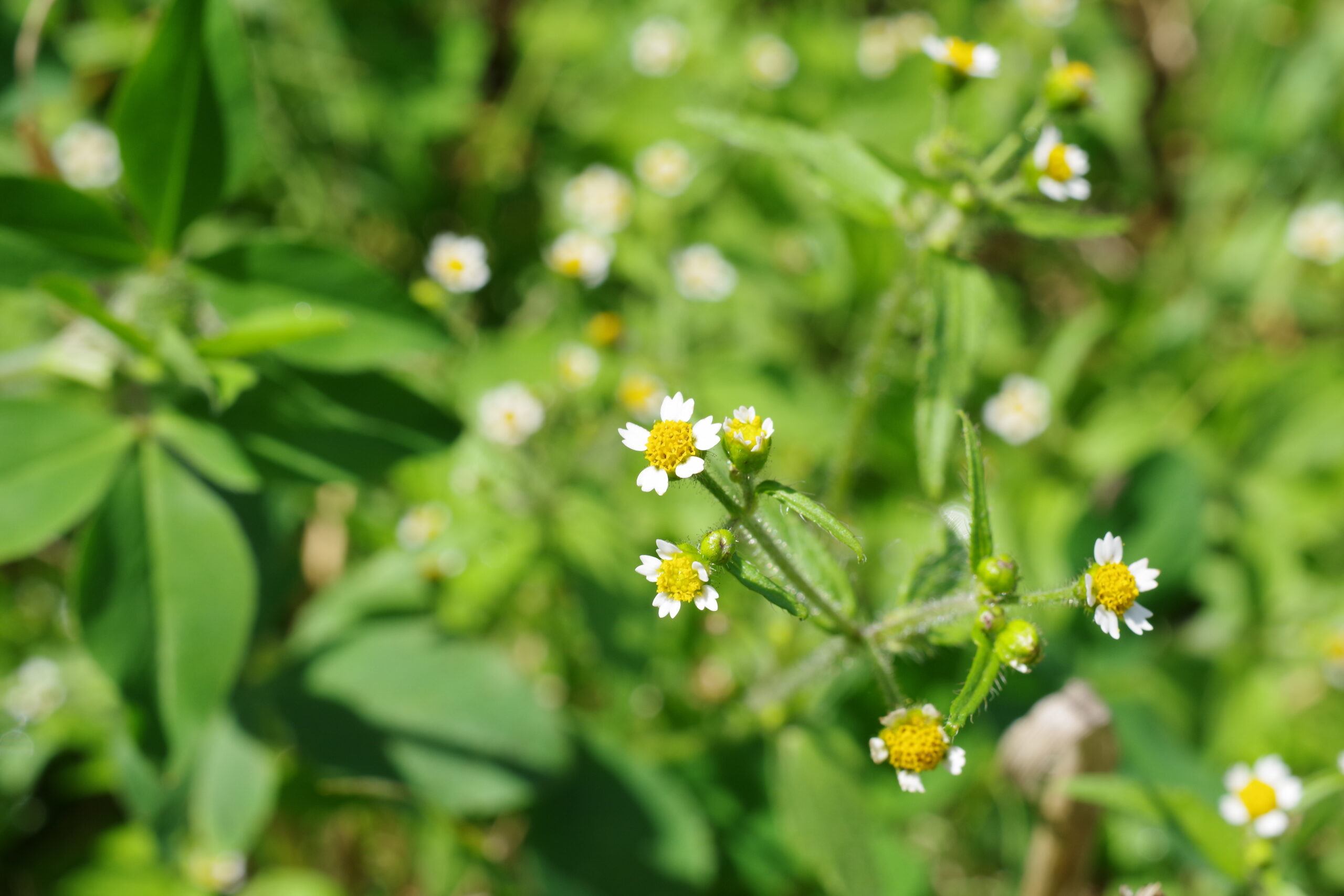
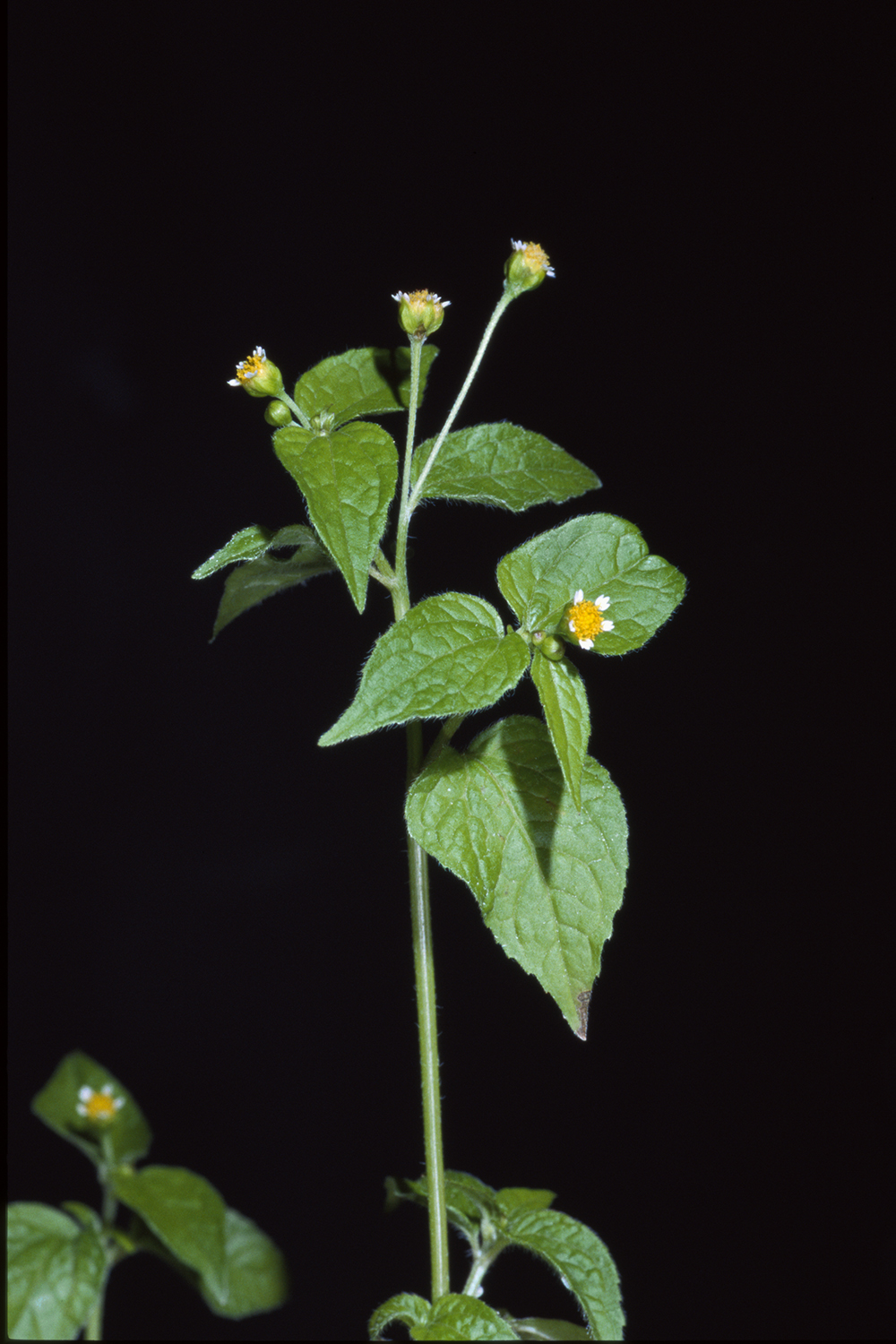
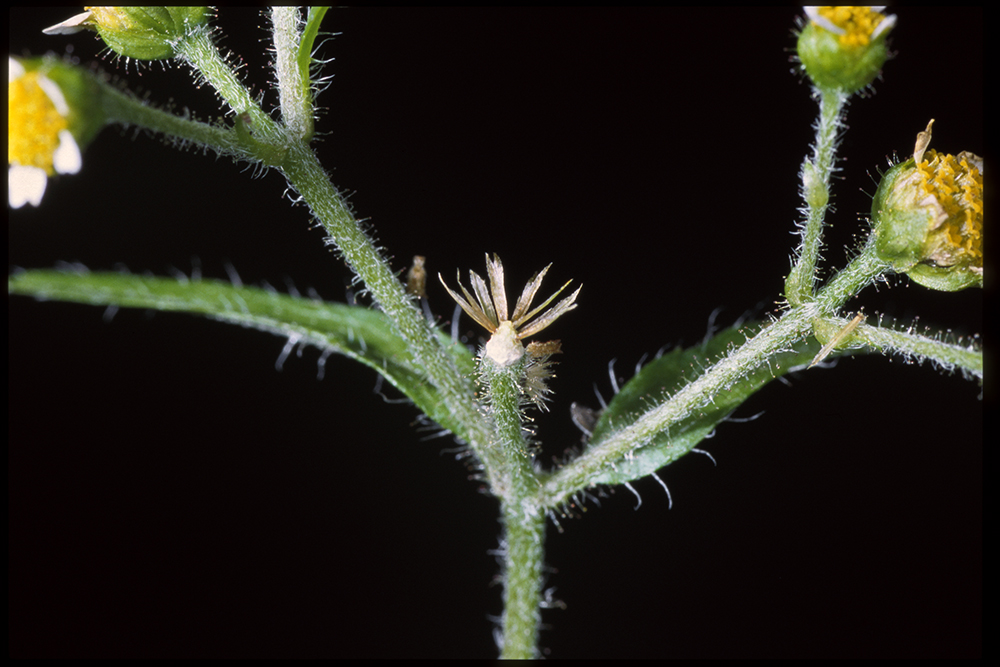
Hairy galinsoga, Galinsoga quadriradiata Cav. = G. ciliata (Raf.) S.F. Blake
Smallflower galinsoga, Galinsoga parviflora Cav.
Identification of Galinsogas
Family: Aster family, Asteraceae
Habit: Highly branched, summer annual herbs
Description: Seedlings have 0.4 inch-long, stalked cotyledons and opposite young leaves.
- Hairy galinsoga: Cotyledons are hairless and square or egg shaped, with flattened, slightly indented tips. Seedling stems are short, green and sometimes turn maroon with time. Young leaves are triangular or egg shaped and light green, with a pointed tip. Three prominent veins are red tinged above and hairy below. Dense hairs are present on the stem, stalks, toothed leaf edges and upper leaf surface; hairs located on leaf edges point toward the leaf tip.
- Smallflower galinsoga: Cotyledons are round to lima bean shaped, with indented tips and a fringe of tiny hairs along the margin. Young leaves are paddle shaped to broadly oval, slightly cupped and sometimes toothed, with a tapered tip. Very young leaves are grooved along one to three veins.
Mature plants are upright and much-branched. Branching occurs in even pairs from axils of the opposite leaves.
- Hairy galinsoga: Densely hairy stems reach 4–28 inches in height. Coarse hairs are present on leaf stalks, the entire upper leaf surface and veins on the lower leaf surface. The broad leaves are 1–3 inches long by 0.5–2 inches wide, egg shaped to triangular, with coarsely toothed, hairy edges. Roots are shallow and fibrous.
- Smallflower galinsoga: Irregularly hairy stems are 12–24 inches tall. Hairs are concentrated near stem-leaf joints and on leaf stalks. Leaf stalks are 0.5 inch long, thin and may be absent on younger leaves. Leaves are egg shaped to lance-egg shaped with a pointed tip, 0.3–4.25 inches long by 0.1–2.75 inches wide, light green and finely to coarsely toothed. A small taproot may be present.
Flower heads of both species are clustered at branch ends; they have four to five small, usually white, 0.1 inch-long ray flowers. Petals have three rounded teeth at their tip. The center of the flower head is a mounded group of distinct yellow disk flowers that each produce one seed.
- Hairy galinsoga: Flower heads are 0.25 inch in diameter, with occasional pink petals. Petaled ray flowers do not produce seeds.
- Smallflower galinsoga: Flower heads are 0.13 inch in diameter. Petals are only white, and the petaled ray flowers produce seeds. There are 15–50 yellow disk flowers per ray flower.
Fruit and seeds: The apparent seeds are covered with a tight hairy coating of fruit tissue. These four-sided seeds are topped with a crown of papery brown scales.
Hairy galinsoga: Seeds are 0.1 inch long and torpedo shaped.
Smallflower galinsoga: Seeds are 0.06 inch long and cylinder or oval shaped. Slightly wedged seeds are derived from the ray flowers.
Similar species: Seedlings can be confused for Virginia copperleaf (Acalypha virginica L.), but the two can be distinguished by looking for the notched, not broadly indented, tip of the Virginia copperleaf cotyledon. Unlike Galinsoga spp., all but the first true leaves of Virginia copperleaf are alternate.
Management of Galinsogas
Hairy and smallflower galinsoga are particularly problematic in low-growing vegetable and specialty crops. Since their seeds do not persist for more than a couple of years in the soil, one of the best tactics for managing these weeds is to rotate fields into a sod crop periodically. Three or four years in sod is usually sufficient to nearly or even completely eradicate an infestation. Reduction of the population will be more complete if galinsoga is prevented from going to seed during the establishment of the sod, for example by use of a nurse crop or mowing. A few years of aggressive control to avoid seed production can also greatly reduce populations. For example, a competitive summer annual cover crop can reduce galinsoga seed production by more than 98%. After the seed bank has been depleted, avoid reintroducing galinsoga in soil clinging to shoes and machinery.
Controlling the galinsogas requires regular attention. Because these species go to seed so rapidly, clean up fields immediately after harvest to reduce population growth. During summer fallow periods, either keep the soil clean cultivated at three- to four-week intervals to flush out seedlings, or plant with a competitive cover crop. If time and the season permit, try to work in a tilled fallow period before planting. Since the seeds can only emerge from the top 0.4 inch of soil, a thorough cultivation at shallow depth can effectively deplete the surface seed bank without bringing up new seeds.
Two alternatives are available for handling very heavy seedings that result from an occasional year with poor control. First, since the seeds mostly germinate near the soil surface, do not till between seed production and when the first flowers appear on spring germinating plants. Most of the seeds will have germinated by then and will be destroyed when a seedbed is prepared for an early summer crop. Second, moldboard plow the seeds under as deeply as you can. For the next few years use relatively shallow tillage while the deeply buried seeds die off.
Ecology of Galinsogas
Origin and distribution: Both species originated in Central America. Both species occur in moist areas of the United States, primarily in the Northeast and northern states of the Midwest, with scattered occurrence elsewhere in the moister parts of the United States. Both species are widespread in temperate and tropical North and South America, and they have been introduced into various parts of Europe, Asia, Africa and Australia. They are rare in dry regions of the world, even in irrigated crops.
Seed weight: Mean population seed weights of hairy galinsoga range from 0.19–0.23 mg. Mean population seed weights of smallflower galinsoga range from 0.17–0.27 mg.
Dormancy and germination: Freshly shed seeds of both species will germinate immediately if exposed to light and warm temperatures. However, seeds of hairy galinsoga shed in summer were dormant until late fall in the Czech Republic, and some lots of smallflower galinsoga harvested in summer months were dormant. Germination approaches 100% in light at constant temperatures ranging from 54–97°F or at fluctuating day/night temperatures ranging from 59/50°F to 95/68°F, but it decreases at cooler temperatures of 59/43°F or lower. Both species show markedly reduced germination in the dark, which allows them to persist until the following season when buried in the soil. Nitrate has no effect on germination.
Seed longevity: Studies of seed longevity are limited. In India, soil seed populations declined by more than 99% in cropland from winter to summer due to a combination of emergence and mortality. In Mexico, viability of seeds from disk flowers of smallflower galinsoga declined by approximately 70% in the first year after burial, whereas those from ray flowers declined by approximately 50%. The general absence of galinsoga from farms where row crops are rotated with several years of sod indicates that few seeds survive in the soil for more than three years.
Season of emergence: Emergence begins in early spring, peaks in late spring and early summer but continues until frost, particularly following soil disturbance.
Emergence depth: Only seeds at or very near the soil surface produce seedlings. Most galinsoga seeds produce seedlings when positioned on the soil surface, but only half emerge from 0.1 inch, and none emerge from 0.4 inch.
Photosynthetic pathway: C3
Sensitivity to frost: Both species of galinsoga die when exposed to even mild frost.
Drought tolerance: Both species are drought sensitive. Hairy galinsoga is somewhat less sensitive to drought than tomatoes.
Mycorrhiza: Smallflower and hairy galinsoga are mycorrhizal.
Response to fertility: Both species thrive when N, P and K levels are all high, whereas low levels of any of these nutrients will reduce growth and flowering. In the year following a corn crop, hairy galinsoga showed a much stronger response to P with no added N than to N with no added P. At reduced levels of N and K, smallflower galinsoga increases root growth, but hairy galinsoga does not.
Soil physical requirements: Both species occur on a variety of soil types but prefer damp, rich soil.
Response to shade: Both species grow best in full sunlight and show markedly reduced growth when shaded. Hairy galinsoga exhibits strong shade avoidance responses when grown in competition, including increased stem length and leaf area, delayed flowering and seed production, and greatly reduced biomass and seed production.
Sensitivity to disturbance: Plants of all sizes usually wilt quickly when uprooted unless the weather is unusually wet. Stem fragments buried in moist soil can apparently produce roots, thereby facilitating their persistence in cultivated vegetable crops. Well-rooted plants tend to break near the base when pulled or hoed and then quickly regenerate.
Time from emergence to reproduction: Plants flower until the first killing frost. Both species first flower 24–60 days after emergence. Flowering time of hairy galinsoga was delayed from 34 days in the absence of competition to 46 days under competitive conditions, but always occurred when there were 10 leaves on plants. Seeds are released eight to 14 days after flowering.
Pollination: Both species readily self-pollinate but are also cross pollinated by insects.
Reproduction: Once a plant begins to flower, it will continue to grow and flower until frost. Consequently, early emerging plants that are not killed by human intervention can produce many seeds. Medium sized plants of hairy galinsoga about 18 inches in diameter averaged 40,000 seeds per plant. Plants grown in the absence of competition produced approximately 25,000 seeds within 67 days, whereas those grown under moderate competition within a broccoli crop produced no more than 4,000 seeds per plant during the same time period. A plant of smallflower galinsoga in Japan produced 400,000 seeds. Since plants mature rapidly and seeds can germinate immediately upon dispersal, both species are capable of completing three to four generations per year in the Northeast.
Dispersal: Seeds disperse short distances by wind, but the fine hairs attached to the seed are much reduced relative to most wind dispersed species in the aster (composite) family. The seeds are hairy and stick readily but not persistently to fur and clothing.
Common natural enemies: Both species are commonly attacked by a diversity of aphid and leafhopper species. They are also susceptible to galinsoga mosaic virus.
Palatability: Leaves, stems and flowers of hairy galinsoga are cooked in soups in southern Mexico. Smallflower galinsoga contains high concentrations of protein and minerals and is consumed as a leafy vegetable in several areas of the world.
Summary Table of Galinsogas Characteristics
| Galinsogas | ||||||||
|---|---|---|---|---|---|---|---|---|
| Growth habit | Seed weight (mg) | Seed dormancy at shedding | Factors breaking dormancy | Optimum temperature for germination (F) | Seed mortality in untilled soil (%/year) | Seed mortality in tilled soil (%/year) | Typical emergence season | Optimum emergence depth (inches) |
| short, branched | 0.17–0.27 | No | li | 54–97 | 50–99 | na | late spring to summer | 0–0.1 |
| Photosynthesis type | Frost tolerance | Drought tolerance | Mycorrhiza | Response to nutrients | Emergence to flowering (weeks) | Flowering to viable seed (weeks) | Pollination | Typical & high seed production (seeds per plant) |
| C3 | low | low | yes | high | 4–8 | 1–2 | both | 10,000 & 100,000 |
Table Key
General: The designation “–” signifies that data is not available or the category is not applicable.
Growth habit: A two-word description; the first word indicates relative height (tall, medium, short, prostrate) and second word indicates degree of branching (erect, branching, vining).
Seed weight: Range of reported values in units of “mg per seed.”
Seed dormancy at shedding: “Yes” if most seeds are dormant when shed, “Variable” if dormancy is highly variable, “No” if most seeds are not dormant.
Factors breaking dormancy: The principle factors that are reported to break dormancy and facilitate germination. The order of listing does not imply order of importance. Abbreviations are:
scd = seed coat deterioration
cms = a period subjected to cold, moist soil conditions
wst = warm soil temperatures
li = light
at = alternating day-night temperatures
ni = nitrates
Optimum temperature range for germination: Temperature (Fahrenheit) range that provides for optimum germination of non-dormant seeds. Germination at lower percentages can occur outside of this range. The dash refers to temperature range, and the slash refers to alternating day/night temperature amplitudes.
Seed mortality in untilled soil: Range of mortality estimates (percentage of seed mortality in one year) for buried seeds in untilled soil. Values were chosen where possible for seeds placed at depths below the emergence depth for the species and left undisturbed until assessment. Mortality primarily represents seed deterioration in soil.
Seed mortality in tilled soil: Range of mortality estimates (percentage of seed mortality in one year) for seeds in tilled soil. Values were chosen for seeds placed within the tillage depth and subjected to at least annual tillage events. Seed losses are the result of dormancy-breaking cues induced by tillage, germination and deterioration of un-germinated seeds.
Typical emergence season: Time of year when most emergence occurs in the typical regions of occurrence for each weed. Some emergence may occur outside of this range.
Optimum emergence depth: Soil depths (in inches below the soil surface) from which most seedlings emerge. Lower rates of emergence usually will occur at depths just above or just below this range.
Photosynthesis type: Codes “C3” or “C4” refer to the metabolic pathway for fixing carbon dioxide during photosynthesis. Generally, C3 plants function better in cooler seasons or environments and C4 plants function better in warmer seasons or environments.
Frost tolerance: Relative tolerance of plants to freezing temperatures (high, moderate, low).
Drought tolerance: Relative tolerance of plants to drought (high, moderate, low).
Mycorrhiza: Presence of mycorrhizal fungi. “Yes” if present; “no” if documented not to be present, “unclear” if there are reports of both presence and absence; “variable” if the weed can function either with or without, depending on the soil environment.
Response to nutrients: Relative plant growth response to the nutrient content of soil, primarily N, P, K (high, moderate, low).
Emergence to flowering: Length of time (weeks) after emergence for plants to begin flowering given typical emergence in the region of occurrence. For species emerging in fall, “emergence to flowering” means time from resumption of growth in spring to first flowering.
Flowering to viable seed: Length of time (weeks) after flowering for seeds to become viable.
Pollination: “Self” refers to species that exclusively self-pollinate, “cross” refers to species that exclusively cross-pollinate, “self, can cross” refer to species that primarily self-pollinate, but also cross-pollinate at a low rate, and “both” refers to species that both self-pollinate and cross-pollinate at relatively similar rates.
Typical and high seed production potential: The first value is seed production (seeds per plant) under typical conditions with crop and weed competition. The second value, high seed production, refers to conditions of low density without crop competition. Numbers are rounded off to a magnitude that is representative of often highly variable reported values.
Further Reading
Damalas, C.A. 2008. Distribution, biology, and agricultural importance of Galinsoga parviflora (Asteraceae). Weed Biology and Management 8: 147–153.
Kumar, V., D.C. Brainard and R.R. Bellinder. 2009. Effects of spring-sown cover crops on establishment and growth of hairy galinsoga (Galinsoga ciliata) and four vegetable crops. HortScience 44: 730–736.
Warwick, S.I. and R.D. Sweet. 1983. The biology of Canadian weeds: 58. Galinsoga parviflora and G. quadriradiata (= G. ciliata). Canadian Journal of Plant Science 63: 695–709.

